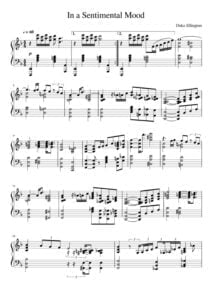Table of Contents
Come join us now, and enjoy playing your beloved music and browse through great scores of every level and styles!
Can’t find the songbook you’re looking for? Please, email us at: sheetmusiclibrarypdf@gmail.com We’d like to help you!
In A Sentimental Mood – Bill Evans Duke Ellington Piano Solo sheet music, Noten, spartiti, 楽譜, 乐谱

Best Sheet Music download from our Library.

Please, subscribe to our Library.
If you are already a subscriber, please, check our NEW SCORES’ page every month for new sheet music. THANK YOU!

Browse in the Library:
Or browse in the categories menus & download the Library Catalog PDF:
Duke Ellington’s “In a Sentimental Mood”: Elegance Personified & Bill Evans’ Harmonic Alchemy
The Birth of a Standard: Ellington’s Moment of Inspiration (1935)

Duke Ellington’s “In a Sentimental Mood” emerged not from a grand plan, but from a serendipitous moment in 1935. Legend has it that Ellington improvised the melody on piano to comfort a distressed friend, Miss Delores “Mercer” Frazier, after a minor accident. The setting was Durham, North Carolina, perhaps adding to the intimate, Southern-grace atmosphere of the piece. While Ellington is credited as composer, his longtime collaborator and saxophonist Otto “Toby” Hardwick is often acknowledged as contributing significantly to the harmonic structure.
- First Recording (1935): The Duke Ellington Orchestra recorded it on April 30, 1935, featuring Hardwick’s breathy, evocative alto saxophone solo. This original version established the song’s core DNA: a slow, stately tempo, a yearning, chromatic melody, and a sophisticated yet accessible harmonic progression rooted in the key of D major (though often played in other keys).
- Structure & Initial Harmony: It’s a classic 32-bar AABA form. The harmony, while beautiful, was relatively straightforward by later jazz standards:
- A Sections: Primarily tonic (D) and dominant (A7) movement, with passing chords like ii (Em7) and vi (Bm7), and a characteristic move to the relative minor (Bm) in bar 3.
- Bridge (B): Moves through a cycle of dominants (G#7 – C#7 – F#7 – B7), creating harmonic momentum before resolving back to the tonic for the final A.
- Legacy: The song was an instant success, embraced by singers (Ella Fitzgerald, Frank Sinatra) and instrumentalists alike. Its inherent elegance, memorable melody, and solid structure made it a perfect vehicle for interpretation.
Bill Evans: Reimagining Sentimentality (1962)
Fast-forward to 1962. Pianist Bill Evans, already renowned for his introspective lyricism, revolutionary harmonic concepts (developed partly with Miles Davis on Kind of Blue), and impressionistic touch, recorded Undercurrent, a landmark duo album with guitarist Jim Hall. Their version of “In a Sentimental Mood” stands as one of the most definitive and influential interpretations, particularly for its harmonic sophistication.
- Context: Evans was at a creative peak, deeply influenced by classical composers like Ravel and Debussy. Undercurrent captured an intimate, chamber-jazz aesthetic, perfectly suited to the mood of the song. This recording came shortly after the tragic death of Evans’ bassist Scott LaFaro, adding a layer of profound melancholy to his playing.
- Evans’ Harmonic Transformations:
Evans didn’t just play the tune; he recomposed its harmonic landscape, applying his signature techniques:- Chromatic Descending Basslines: Evans often underpinned progressions with smooth, chromatic bass movement, adding richness and direction. Listen to the intro and throughout the A sections.
- Tritone Substitution: This became an Evans hallmark. He frequently replaced dominant 7th chords with another dominant 7th chord a tritone away. For example:
- Instead of the standard
A7leading toDmaj7(bars 7-8), Evans might useEb7(the tritone sub of A7), creating a lush, unexpected color (Eb7 -> Dmaj7). - He applied this liberally throughout, especially to dominant chords in the bridge and turnaround.
- Instead of the standard
- Chord Extensions & Alterations: Evans thickened and colored the basic chords extensively:
- Adding 9ths, 11ths, and 13ths (e.g.,
Dmaj9,Em11,A13). - Using altered tensions like #9, b9, #11, and b13 on dominant chords (e.g.,
Eb7#9,A7alt) for greater dissonance and resolution. - Turning simple minor chords into minor 11ths or minor-major 7ths for added complexity.
- Adding 9ths, 11ths, and 13ths (e.g.,
- Modal Interchange/ Borrowed Chords: Evans borrowed chords from parallel modes (e.g., D minor while in D major). This might involve using a
Dm7where aDmaj7was expected, or aGm7instead ofGmaj7, adding poignant darkness. - Reharmonizing the Bridge: While keeping the cycle-of-fifths motion intact, Evans saturated the bridge dominants with rich alterations and substitutions, making the progression shimmer with complex colors. A simple
G#7might becomeG#7#11or be approached via a tritone sub (D7 -> G#7). - Intro & Outro: Evans crafted a unique, harmonically ambiguous introduction and outro, setting the mood with lush, clustered chords and open intervals that felt both nostalgic and modern.
- Melodic & Rhythmic Approach: Evans respected the melody’s beauty but phrased it with his signature rubato (subtly stretching and contracting time), letting notes ring and breathe. His touch was luminous and delicate. His improvised solo choruses seamlessly integrated with the reharmonized structure, exploring the new harmonic pathways he had created with his characteristically lyrical lines.
- Impact: Evans’ version didn’t just reinterpret the song; it redefined its harmonic possibilities for generations of jazz musicians. It became the benchmark for modern harmonic treatment of standards. His approach demonstrated how deep reharmonization could enhance the emotional core of a piece rather than obscure it.

Why Evans’ Version Endures:
- Harmonic Depth: He elevated the song’s inherent beauty with layers of sophisticated, yet emotionally resonant, harmony.
- Emotional Intensity: His playing, imbued with personal grief and profound sensitivity, captured the deep, complex sentimentality hinted at in Ellington’s title more intensely than perhaps any other version.
- Timeless Aesthetic: The duo setting with Hall and Evans’ impressionistic harmony created a sound that feels both classic and modern, transcending its era.
- Influence: It became a masterclass in jazz reharmonization, studied and emulated by countless pianists and arrangers.

Duke Ellington’s “In a Sentimental Mood” is a timeless masterpiece of melodic grace and elegant harmony. Bill Evans, through his 1962 recording with Jim Hall, performed an act of profound musical alchemy. By applying his revolutionary harmonic language – chromaticism, tritone substitutions, rich extensions/alterations, and modal interchange – Evans transformed the song’s structure while magnifying its emotional essence. He didn’t replace Ellington’s sentimentality; he deepened it, creating a version that stands as a pinnacle of jazz interpretation and continues to inspire awe with its harmonic beauty and emotional depth.
